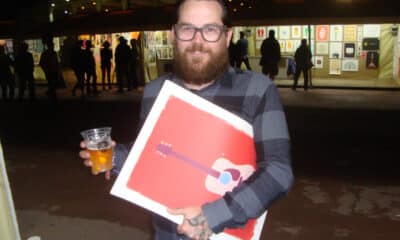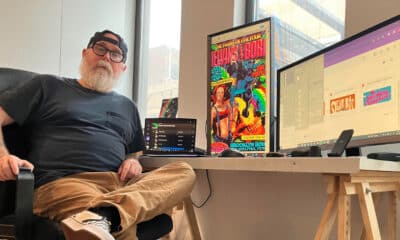Andy MacDougall
Squeegee United: Beyond Decorated Apparel
Throughout its rollercoaster history, the diverse, often underrecognized screen printing community has never craved the spotlight. The future looks no different.
Published
5 months agoon
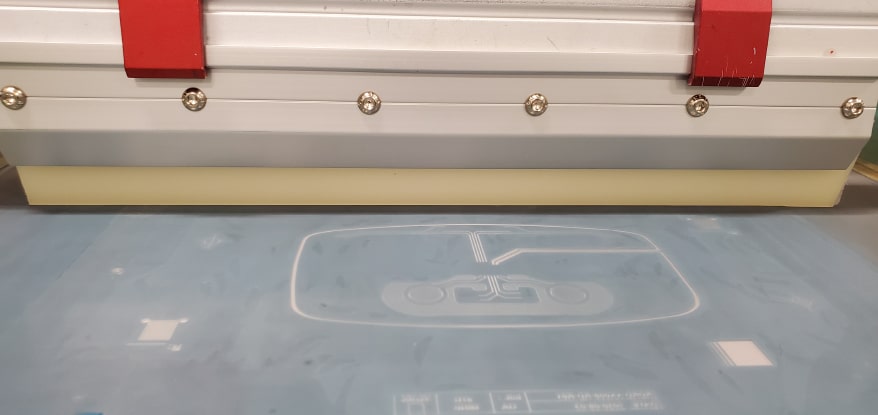
PODCAST NUMBER 18 of Art, Ad, or Alchemy is up. It’s taken 3 human years to get here, or 21 dog years, for those who like alternative facts, but those numbers confuse things. Time seemed slower during Covid; now things are back to SNAFU. And after 17 conversations with a global cross section of screen printers, one thing is clear: We are all linked by a common thread. Excuse the pun, but it’s woven into our mesh, the squeegees we use to print, and the stencils that control the image.
It’s what makes us unique in the wider print world, this process of printing with a stencil. It allows us to operate in a kind of hidden stealth mode, slightly different in each industry. Textile, electronics, biomedical, glass and ceramic, posters and fine art, advertising, energy cells and batteries — we are all different, yet we have a common link in the screen printing process.
This market is exceedingly diverse, with screen printers working and playing in areas even other screen printers know little about. My first Podcast was with a medical device maker that switched from making diabetic test strips to developing rapid Covid test strips. Other episodes featured T-shirt printers, representing the mass of textile decorators that keep us colorful around the world. Still others featured fine-art serigraphers and poster makers for your favorite rock band (this being this Canukian’s favorite place in the SPU – Screen Print Universe).
Then there are the people printing the future — electronics printers who favor screen printing because it works, it’s fast, and it has not been surpassed in cost, efficiency, and adaptability by other print processes, regardless of the hype from the digital side of the aisle. In the material sciences world, we find solar and hydrogen fuel cell manufacturers, battery manufacturers, and we even have some scientists working on using screen printing to rebuild broken spinal cords (more on that as it develops).
Talk about diversity — some screen printers use a home-built setup, while others run a multi-million dollar production line. Talk about opportunity — in this world, few other business models can be started with next to nothing and grown based on acquired skills. Screen printers do it every day. All have one thing in common: that floppy rubber-like blade we use to squish the ink, or the paste, or the — dare I say it — PAINT (a trigger word in this industry) through the mesh and onto the object being printed. The squeegee is the uniter of us all, not the product. A simple fact, but lost on many.
Did you know that way, way back, pioneer printers Beck and Owens tried to get a patent on the squeegee, but lost out to the window washers of the world? If you don’t believe me, go look it up in the dictionary — we don’t even make it to the subheadings! The common tool of the process that prints the shirts and solar cells and control interfaces of literally every electronic device … is subservient to the squeegee kid on the corner.
Luckily for us, most screen printers I know could give the proverbial rat’s ass about whether we get a mention in the dictionary. They are too busy working, learning, growing, and fighting the daily battle to stay in business. We’re analog players with our feet dipped firmly in a hybrid digital future, with a cloudy past and a confusing present.
Advertisement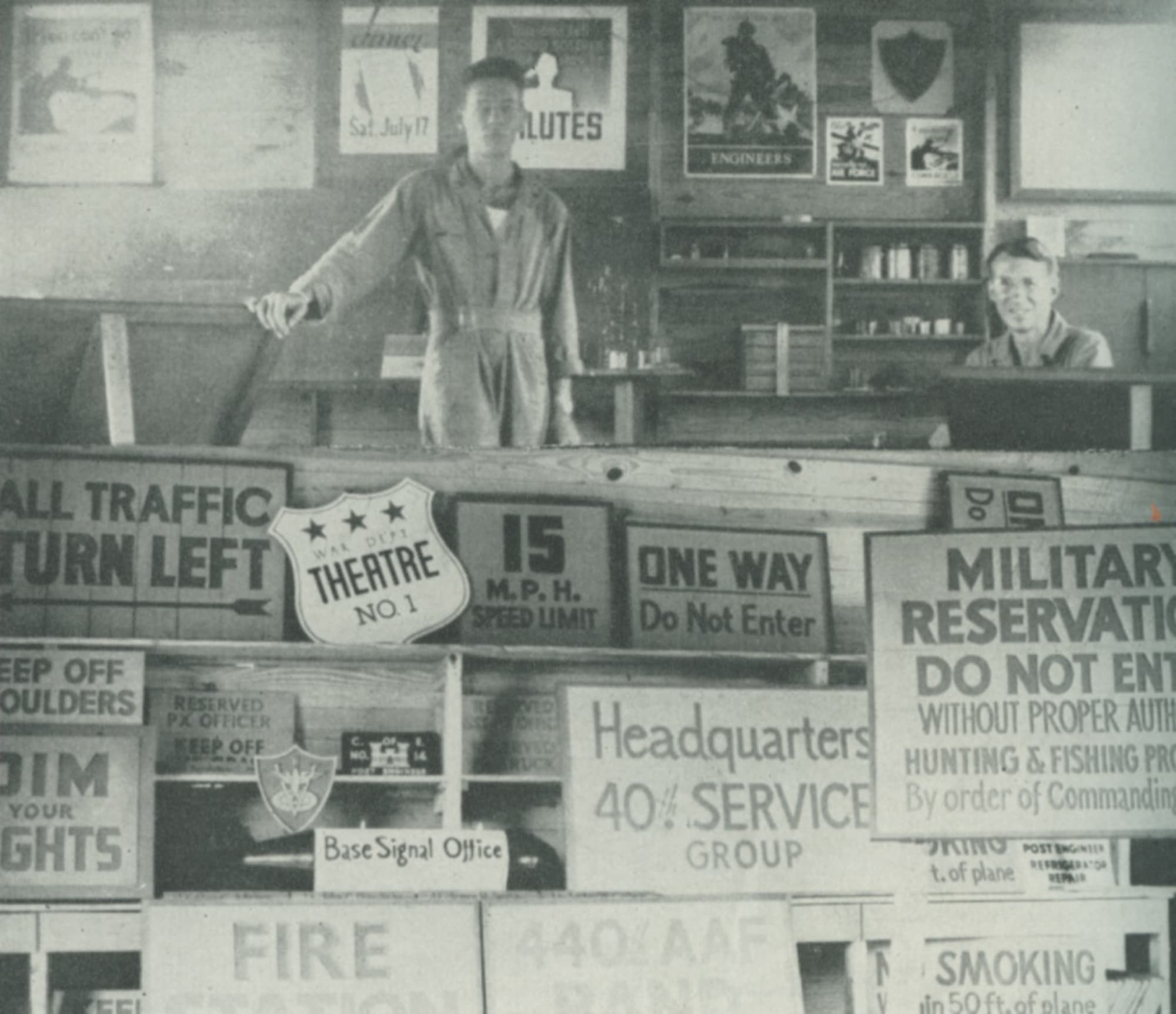
Historically Speaking
This magazine got started as an offshoot of Signs of the Times, the grandaddy of graphic periodicals, 70 years ago. The publishers decided the screen process was different enough from sign-making to deserve its own platform. Meanwhile, the Screen Process Printing Association — one of the organizations that eventually morphed into today’s Printing United — had been going for a couple of years, and took small steps to consolidate and grow, first in the United States and Canada and then worldwide.
John Kay, one of the original founders of the organization in 1948, wrote a fascinating synopsis of the evolution of screen printing 50 years later in 1998. Much of what happened during that half century led directly to where we are now as a tribe of squeegee draggers.
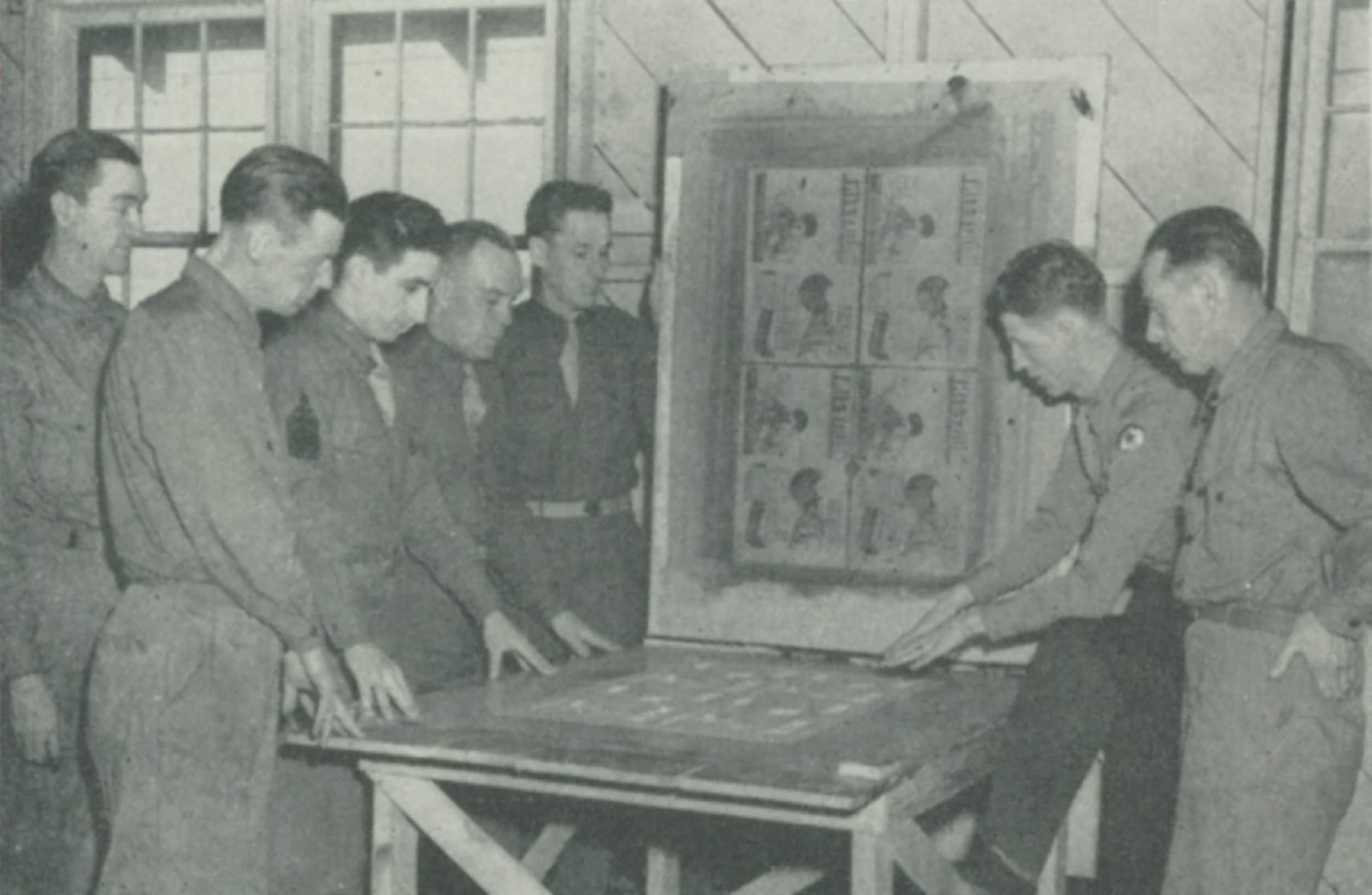 Trained to screen-print everything from propaganda posters to bomb proximity fuses, soldiers brought their newfound skills home after World War II.
Trained to screen-print everything from propaganda posters to bomb proximity fuses, soldiers brought their newfound skills home after World War II.
Massive growth in the late ‘40s was mostly due to trained screen printers exiting the military. Screen printing had gone to war, and helped win. With this amazing process, applications ranged from marking GI’s shirts and propaganda posters to making fake tanks for D-Day. All required only skill and a few simple tools. Mobile sign shops cranked out directionals and posters right next to the front lines in a landscape devoid of monster-big lithography presses that had been bombed to pieces. Screen printing facilitated the production of control stickers and instrument markings (over 3,000 in a B-29), as well as some of the first printed circuits (one of the most famous examples was then-top-secret proximity fuses for bombs).
The association grew in the postwar years. In 1963, leadership decided to throw in with the Printing Industries of America (PIA) — safety in numbers, hanging with the big dogs? At the time, PIA was massive because printing employed more people than any other industry in the U.S.
After two years, the screen association cancelled the agreement and started rebuilding its own organization. In ’67 it created divisions focused on specific products, always with the idea of strengthening member businesses through research and education, as well as promoting the growth and use of the process outside the printing industry. In ’68 the name changed to Screen Printing Association International. In ‘69, John Crawford took over. The organization grew by leaps and bounds under his guidance as screen printing created new markets in outdoor, specialty graphics, textile and T-shirt printing, industrial applications, and the emerging world of electronics (printed circuits). In 1973, the Academy of Screen Printing Technology was formed — that’s a 50-year anniversary this year.
Advertisement 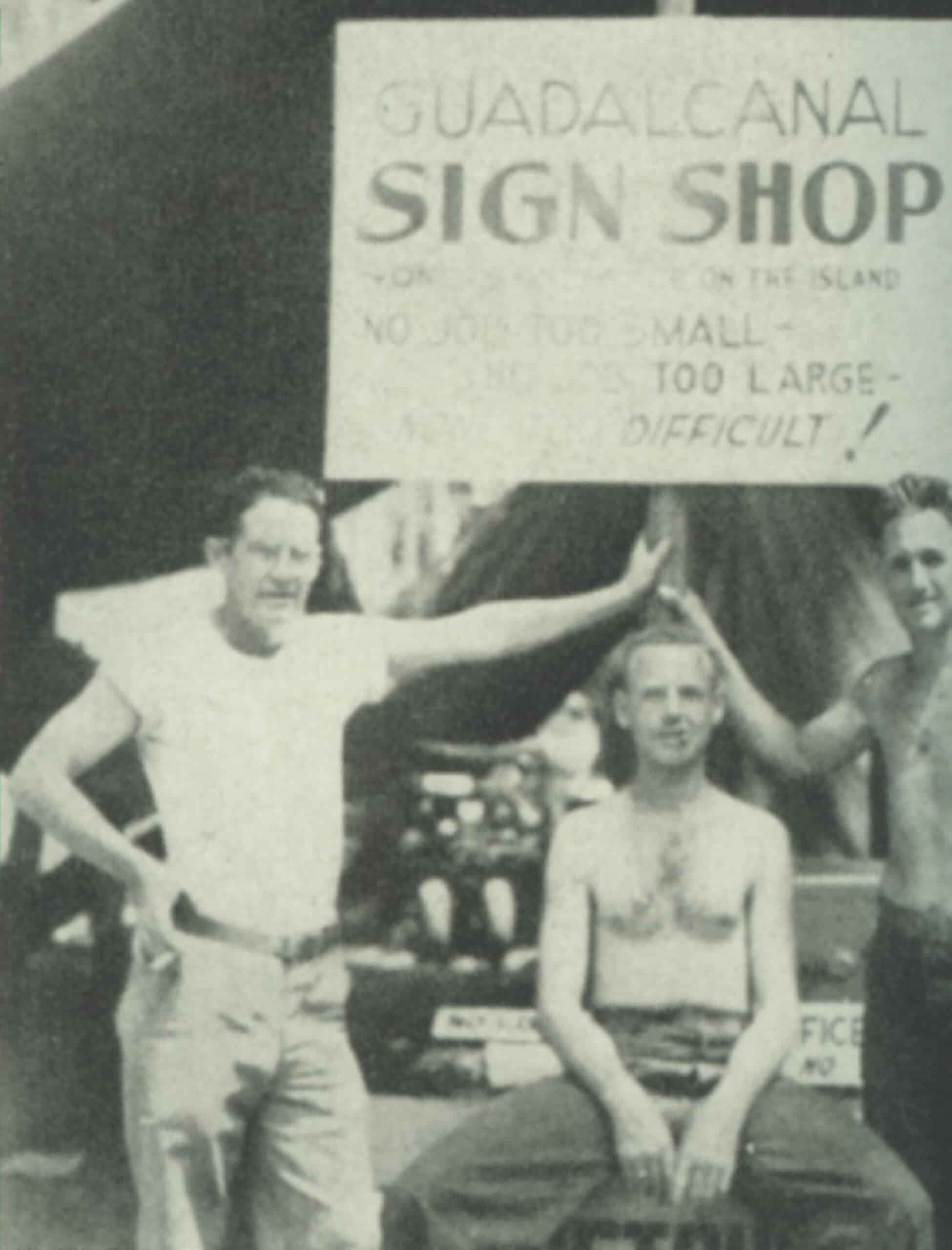 Mobile sign shops, like this example from Guadalcanal, aided Allied communications in every theater of the war.
Mobile sign shops, like this example from Guadalcanal, aided Allied communications in every theater of the war.
Modern Times
Continued growth and the inclusion of the newly emerging wide-format ink jet sector brought the organization forward into the new century, and in a classic reversal of fortune, the PIA and the offset industry gradually collapsed as social media and digital printing eroded the traditional “ink on paper” sector. By then, the Academy (now the Academy of Screen and Digital Print Technologies, or ASDPT), was part of the Specialty Graphic Imaging Association (SGIA), representing screen and digital printers. The SGIA continued to grow, but in 2018 the remains of the PIA came in through the backdoor. In 2020, the combined organizations formed the Printing United Alliance. The recent trade show in Atlanta is the result of that union.
In the process, screen printing often seemed relegated to the fringes in what is promoted and pushed as “print” — same as it ever was. We were always a niche process to begin with. COVID-19 stuck a knife into the corpse. What emerged seemed to me to be top-heavy with digital and “traditional” printing. Screen printing was defined by textile applications, with contributions in other areas virtually ignored. The trade show has become the end-all be-all of the organization. But what do I know? A cranky old screen printer criticizing the way things evolved. In a world of constant change, this is where we are now.
Moving Forward
We can’t sit here looking at our belly buttons while the world goes on its merry way. If Printing United is our organization, and we are all printers looking out for opportunities and growth, we should encourage the organization to look at the past as it charts a way toward the future. Specialty printing – I’ll define that as anything not being printed on paper – is the way forward. Sure, there are always going to be the traditional offset printers, statistically the biggest players, but as digital communication continues to replace the newspaper and magazine, that dominance and definition of “print” is a handicap. Printing United and the member companies face a shortage of younger people, just like many other industries. If the image of print to public, the government, and the educational sector is an NCR form or a newspaper, how can we attract young workers who are willing to train and learn and be part of our new world?
We as printers need to redefine print in the public eye. Printing United has a role to play in this. I personally think screen printing has led the way through diversified usage in a variety of otherwise unrelated industry sectors, particularly electronics and medical.
No matter what happens, these sectors will continue to grow in North America and around the world. How many people know that their cell phone is full of printed parts? Or that COVID-19 rapid test material was screenprinted? Or solar cells and hundreds of other everyday items? I’m hoping Printing United brings attention to and draws in these industry sectors. They represent growth opportunities and opportunities to expand the definition of ‘print’. Sometimes I think the printing industry itself doesn’t recognize the size of the iceberg and the amount of printing that goes on below the surface. The coming convergence of electronics and textile, in the form of active clothing and integration into the Internet of Things, is way below the horizon, but it is there.
There are thousands of companies who skip the club and the trade show and just get on with the business at hand: screen printing. The challenge for Printing United is to be relevant to them. Whether you’re at the kitchen table trying to do a run of posters or you’re running a cylinder press cranking out medical devices or electrical circuits, know that you are not alone. Sure, none of your friends understand what you do, and people move away at parties when you mention squeegees. We’re never going to be mainstream, but that’s OK. Where’s the fun in that?
I hope you’ve enjoyed the conversations since we started this podcast thing, and picked up useful knowledge, and maybe learned a little bit more than you knew the day before. Because that’s the bottom line — to learn a bit more, to advance your skill incrementally, to stay at it over the long haul. I know I have learned with every interview. I love that “Wait, WHAT?” moment when a guest drops some new twist to a very old story and we hear about another screen printing success or innovation.
AdvertisementAndy MacDougall is a screen printing trainer and consultant based on Vancouver Island in Canada, and a member of the Academy of Screen & Digital Printing Technology. If you have production problems you’d like to see him address in “Shop Talk,” email your comments and questions to andy@squeegeeville.com

SPONSORED VIDEO
Let’s Talk About It
Creating a More Diverse and Inclusive Screen Printing Industry
LET’S TALK About It: Part 3 discusses how four screen printers have employed people with disabilities, why you should consider doing the same, the resources that are available, and more. Watch the live webinar, held August 16, moderated by Adrienne Palmer, editor-in-chief, Screen Printing magazine, with panelists Ali Banholzer, Amber Massey, Ryan Moor, and Jed Seifert. The multi-part series is hosted exclusively by ROQ.US and U.N.I.T.E Together. Let’s Talk About It: Part 1 focused on Black, female screen printers and can be watched here; Part 2 focused on the LGBTQ+ community and can be watched here.
You may like
Advertisement

Atlantis Headwear Goes Solar for Sustainable Future

Comfort Colors Announces New Proprietary Dyeing Process Called “Pigment Pure”

10 Production Scheduling Secrets That Will Have Your Team Ready to Rock
Advertisement
Subscribe

Bulletins
Get the most important news and business ideas from Screen Printing magazine's news bulletin.
Advertisement
Most Popular
-

 Case Studies2 months ago
Case Studies2 months agoHigh-Density Inks Help Specialty Printing Take Center Stage
-

 Art, Ad, or Alchemy2 months ago
Art, Ad, or Alchemy2 months agoF&I Printing Is Everywhere!
-

 Andy MacDougall2 months ago
Andy MacDougall2 months agoFunctional and Industrial Printing is EVERYWHERE!
-

 Columns4 weeks ago
Columns4 weeks ago8 Marketing Mistakes Not to Make When Promoting Your Screen Printing Services Online
-

 Editor's Note3 weeks ago
Editor's Note3 weeks agoLivin’ the High Life
-

 Marshall Atkinson3 weeks ago
Marshall Atkinson3 weeks agoHow to Create a Winning Culture in Your Screen-Printing Business
-

 Thomas Trimingham2 months ago
Thomas Trimingham2 months ago“Magic” Marketing for Screen Printing Shops
-

 News & Trends2 months ago
News & Trends2 months agoWhat Are ZALPHAS and How Can You Serve Them in Your Print Business?
